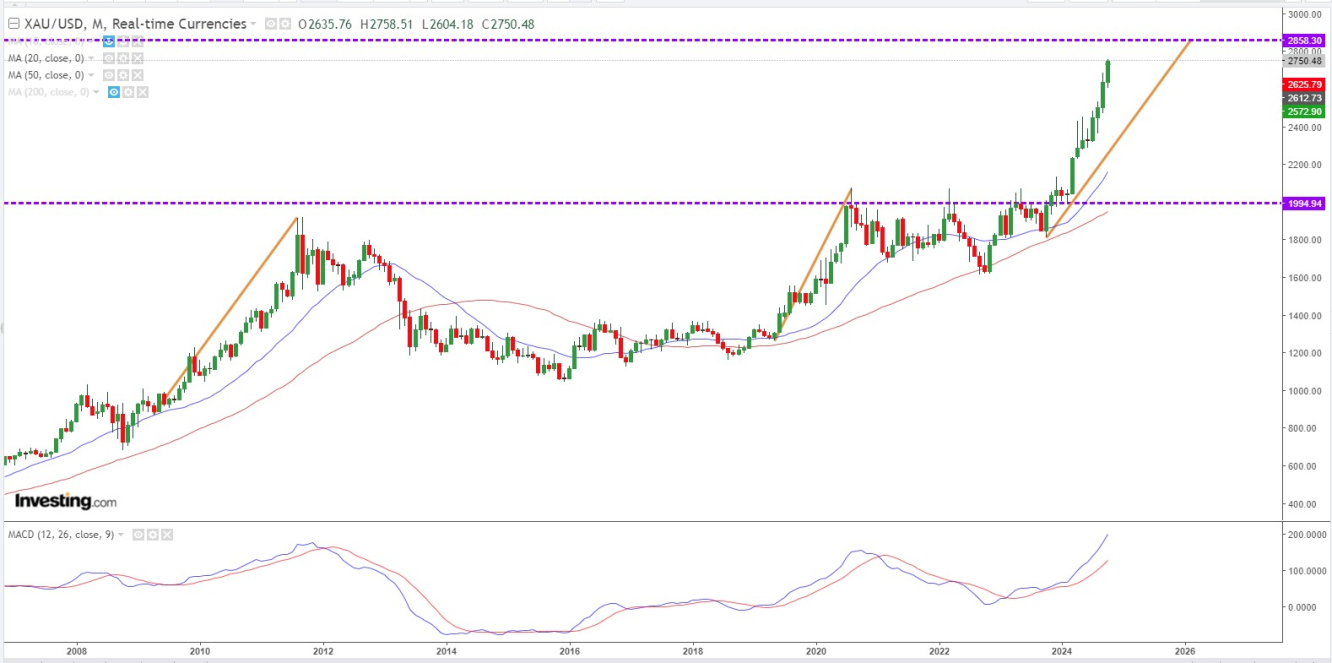The term "bubble" is often thrown around loosely, especially when it comes to commodities with a storied history like gold. Yet, if we examine the current state of gold from a technical analysis perspective, the signs are becoming increasingly hard to ignore: gold is in a bubble.
It's not the first time, and it might not be the last, but understanding where we are in the current cycle is crucial for anyone invested in or trading this metal.
Gold has historically been perceived as a safe-haven asset, often rising in times of economic uncertainty.
However, past instances remind us that even gold, with all its lustre, can become over-extended and prone to dramatic corrections.
Two notable examples are August 2011 and July 2020.
In August 2011, gold reached an all-time high, pushing towards $1,900 per ounce amid a backdrop of financial instability following the 2008 crisis and fears of sovereign debt defaults in Europe.
The narrative was clear: economic uncertainty was at the forefront, and gold was deemed the go-to asset. Yet, this rally peaked and swiftly unravelled over the next few years, leaving many latecomers holding positions that took nearly a decade to recover.
Similarly, in July 2020, gold found itself soaring again, fuelled by pandemic-induced fear and unprecedented central bank interventions. The price pushed above $2,000 per ounce, a new all-time high, as global markets wrestled with the impact of COVID-19. Once again, traders and investors rushed towards gold, seemingly ignoring the signs of an overbought market. It wasn't long before gold corrected, demonstrating once more that even the perceived ultimate store of value has its limits.
Today, we see a similar pattern. Gold's price action exhibits signs of frothiness, with many technical indicators suggesting that it has moved well beyond fundamental value. RSI (Relative Strength Index) readings are consistently indicating overbought conditions. More concerning is the sentiment; media narratives often tout gold as the only hedge against currency devaluation and market instability. Such exuberance, driven by fear or greed, is a hallmark of a bubble mentality.
If we look at the monthly gold chart, there are some clear parallels with previous bubble phases. The chart shows an orange trendline from 2011, which represents the sharp rally leading up to the peak bubble that year. A similar trendline from the current rally has been plotted to gauge the potential scale of the ongoing bubble move. This suggests that if the current bubble persists at the same intensity, gold could potentially reach levels around $2,858 per ounce. This projected target is based on a similar magnitude and momentum as seen during the 2011 bubble.
Additionally, the breakout from recent consolidation, as represented by the second orange trendline, also indicates a critical shift in sentiment that aligns with the characteristics of a bubble move. It is also important to note that price often retraces back to key moving averages, such as the red 50 EMA, which in this case lies closer to the $2,000 mark. This suggests that while the current rally may continue for some time, there is a strong likelihood of a pullback towards this significant support level, reflecting a potential reversion to mean amidst any correction phase.
Key characteristics often seen during market bubbles include:
It's worth mentioning an historical anecdote: during the infamous Tulipomania of the 17th century, Dutch society experienced one of the first recorded speculative bubbles. At the height of Tulipomania, rare tulip bulbs were traded for prices that rivaled those of houses, driven by sheer speculation and a belief that prices would only continue to climb. When the bubble eventually burst, it left many financially ruined, highlighting how powerful mass psychology can become during these periods of irrational exuberance. The characteristics of Tulipomania are strikingly similar to those we see in many other bubbles throughout history, including those observed in commodities like gold.
- Overbought Technical Indicators: Indicators like RSI frequently show extended overbought levels, suggesting that the price is unsustainably high.
- Extreme Sentiment: Excessive optimism or fear driving the price beyond rational valuation, often supported by strong media narratives.
- Rapid Price Increases: Prices tend to rise at an unsustainable pace, driven by speculation and the fear of missing out.
- Divergence from Fundamentals: Asset prices disconnect significantly from their fundamental values, reflecting emotions rather than underlying economic realities.
- High Trading Volumes: Increased volume as more participants enter the market, often including inexperienced investors attracted by hype.
- Widespread Belief in a Single Narrative: A dominant narrative, such as gold being the 'only safe haven,' becomes widespread and unquestioned.
These characteristics are mirrored in the famous Tulipomania bubble:
- Prices rose rapidly and detached from any realistic valuation, much like what occurs with rapid price increases and divergence from fundamentals.
- There was extreme sentiment, where the belief in ever-increasing tulip bulb prices led to reckless purchases, similar to the optimism or fear driving modern bubbles.
- High trading volumes and a single dominant narrative were also present, with many believing that tulip prices could only continue to rise, a belief that proved disastrously incorrect when the bubble finally burst.
However, it is important to recognise that gold's true value may lie closer to the range of $2,100 to $2,250 per ounce. While the current price action suggests overvaluation, the underlying fundamentals and ongoing macroeconomic pressures could support higher valuations over time. Investors should consider the role of inflationary concerns, geopolitical tensions, and the monetary policies of major central banks, which all continue to provide underlying support for gold.
Of course, bubbles can persist far longer than rationality might suggest. We could still see gold trading at these elevated levels, or even higher, for several months. Market bubbles often find ways to persist as participants feed off each other's enthusiasm. Gold, with its historical allure and emotional pull, can easily maintain its price momentum as buyers continue to pile in, hoping for further gains. But traders and investors must tread carefully—historical context shows that once the bubble bursts, the aftermath can be long and painful.
The lessons from August 2011 and July 2020 are critical for today. Both periods were characterised by strong narratives of fear and uncertainty, which propelled gold to unprecedented levels, only to see it correct once the underlying drivers subsided. This serves as a reminder that sentiment can only push an asset so far before fundamentals take over.
Technical traders should be wary of chasing the rally without an exit plan, just as investors should consider whether current prices reflect value or merely exuberance. With the current price of gold approaching its perceived true value range of $2,100 to $2,250, there remains a possibility that the market could recalibrate and bring prices in line with these fundamentals. However, the bubble-like characteristics—overbought technical indicators, extreme sentiment, and the widespread belief that gold is the only refuge—suggest that caution should be the guiding principle.
The takeaway is not necessarily that gold is about to crash tomorrow, but that the current environment bears all the hallmarks of a bubble. The price could continue to move higher as the bubble inflates, but as history has shown, no bubble lasts forever. Prudent investors should assess their exposure and plan for scenarios where gold prices may correct, ensuring that their strategies are aligned with both the potential for continued gains and the risk of a significant pullback.
The gold market is never static; it is as dynamic as the fear and hope that drive it. Right now, we are in a phase where exuberance is evident, but that doesn't mean there isn't room for a rational approach. Traders and investors who keep their eyes open, understand the historical context, and plan accordingly will be better positioned to navigate whatever comes next.
